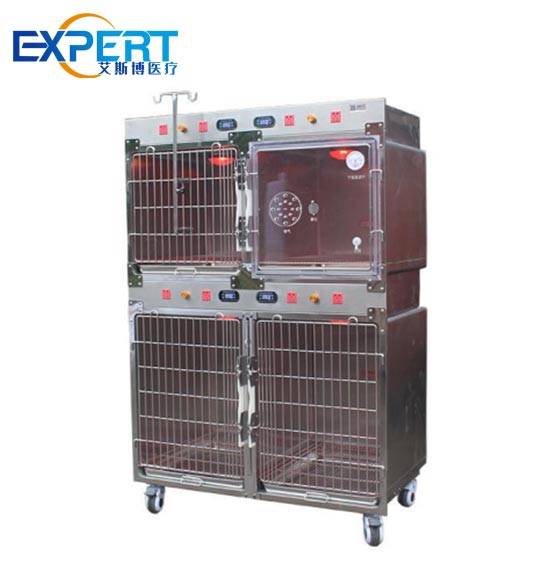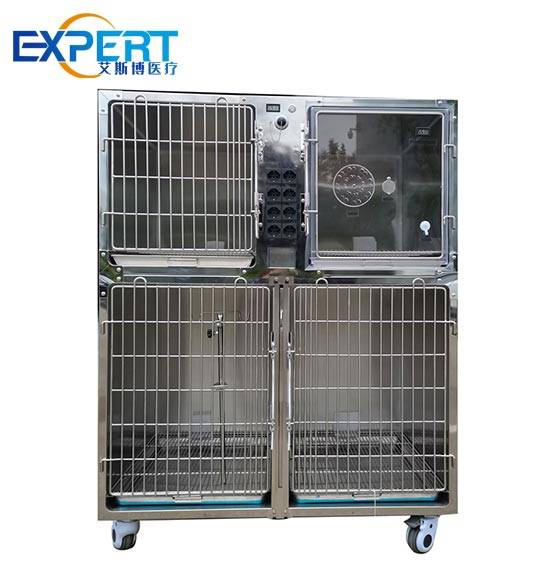Die Anschrift
304 Nordkardinal St.
Dorchester Center, MA 02124
Arbeitsstunden
Montag bis Freitag: 7:00 - 19:00
Wochenende: 10:00 - 17:00
Die Anschrift
304 Nordkardinal St.
Dorchester Center, MA 02124
Arbeitsstunden
Montag bis Freitag: 7:00 - 19:00
Wochenende: 10:00 - 17:00

Veterinary oxygen cages play a crucial role in providing oxygen therapy to animal patients in veterinary clinics and hospitals. These specialized cages are designed to deliver oxygen at controlled levels while ensuring the comfort and safety of the animals. In this comprehensive guide, we will explore the importance of veterinary oxygen cages, their design features, benefits, and how they contribute to the well-being of animal patients.

Veterinary oxygen cages, also known as oxygen kennels or oxygen chambers, are enclosed units that provide a controlled environment for administering oxygen therapy to animals. These cages are typically made of transparent materials such as acrylic or polycarbonate to allow for easy monitoring of the animal’s condition. They come in various sizes to accommodate different species and sizes of animals, ranging from small mammals to large dogs and cats.
Veterinary oxygen cages are equipped with several design features to ensure the comfort and safety of animal patients:
Transparent Construction: The cage walls are made of transparent materials to allow for visual monitoring of the animal’s condition without disturbing them.The flooring of the cage is designed to be comfortable for the animal to walk on, with options for warmth or cooling depending on their needs.
Ventilation: Ventilation systems ensure adequate airflow within the cage while preventing the buildup of carbon dioxide.Improper ventilation can lead to respiratory issues and discomfort for the animals. It is crucial to regularly clean and maintain the ventilation system to ensure optimal air quality for the inhabitants of the cage. Additionally, proper ventilation helps regulate temperature and humidity levels, creating a healthy and comfortable environment for the animals. Regular monitoring of airflow and ventilation systems is essential to prevent any respiratory problems and maintain the well-being of the animals.
Access Ports: Access ports allow veterinarians to administer medical treatments and monitor the animal’s vital signs without opening the cage.Access ports also provide a way to safely handle the animal without causing unnecessary stress or risk of escape. This innovative feature ensures that veterinary care can be provided efficiently and effectively, promoting the health and well-being of the animals in a controlled environment.
Non-Skid Flooring: The cage floor is often equipped with non-skid surfaces to prevent slipping and ensure the animal’s stability.A variety of bedding materials, such as hay, wood shavings, or shredded paper, can be provided to offer comfort and insulation from the cold floor. It is important to regularly clean and replace the bedding to maintain a hygienic environment for the animal. Additionally, some cages may include designated areas for eating, drinking, and playing to promote healthy behaviors and overall well-being. Providing enriching toys and activities can also help prevent boredom and encourage mental stimulation. Overall, a well-equipped cage plays a crucial role in ensuring the safety, comfort, and happiness of the animal residing within it.
Easy Cleaning: Veterinary oxygen cages are designed for easy cleaning and disinfection to maintain a sterile environment for the animals.They are also equipped with oxygen flow meters and pressure gauges to ensure the animals are receiving the appropriate levels of oxygen. Additionally, these cages are designed to provide a comfortable and safe space for recovering animals, with features such as adjustable shelves, access ports for monitoring and treatments, and visibility panels for easy observation.
The use of veterinary oxygen cages offers several benefits for animal patients:
Improved Oxygen Delivery: Veterinary oxygen cages provide a controlled environment for delivering oxygen therapy, ensuring optimal oxygen levels for the animal’s respiratory needs.
Reduzierter Stress: The enclosed design of the cages helps reduce stress and anxiety in animal patients by providing a secure and familiar environment.
Enhanced Monitoring: Veterinarians can easily monitor the animal’s condition and response to treatment through the transparent walls of the cage.
Isolation: Veterinary oxygen cages can be used to isolate contagious animals, preventing the spread of infectious diseases to other patients.
Komfort: The design features of veterinary oxygen cages, such as soft bedding and non-skid flooring, ensure the animal’s comfort during treatment.

| Case Study | Species | Condition | Outcome |
|---|---|---|---|
| Dog with Pneumonia | Canine | Severe respiratory distress | Complete recovery after 48 hours of oxygen therapy |
| Cat with Asthma | Feline | Acute asthma exacerbation | Rapid improvement in respiratory status within hours |
| Rabbit with Anemia | Lagomorph | Hemolytic anemia | Gradual improvement in oxygen saturation over several days |
Veterinary oxygen cages play a vital role in the treatment and management of respiratory conditions in animal patients. By providing a controlled environment for oxygen therapy, these specialized cages ensure the comfort, safety, and well-being of animals undergoing treatment. The design features and benefits of veterinary oxygen cages make them an essential tool in veterinary medicine for delivering effective respiratory care to a wide range of species.
Q: Are veterinary oxygen cages suitable for all animal species?
A: Veterinary oxygen cages are designed to accommodate a wide range of animal species, including dogs, cats, rabbits, and small mammals. However, the size and design of the cage may vary depending on the species and size of the animal.
Q: How long can animals stay in a veterinary oxygen cage?
A: The duration of time an animal spends in a veterinary oxygen cage depends on the severity of their respiratory condition and the response to treatment. Veterinarians will monitor the animal’s progress and adjust treatment accordingly.
Q: Can veterinary oxygen cages be used for post-operative care?
A: Yes, veterinary oxygen cages can be used for post-operative care to provide supplemental oxygen and support the animal’s recovery process. The controlled environment of the cage helps ensure optimal healing and recovery.
Q: How often should veterinary oxygen cages be cleaned and sanitized?
A: Veterinary oxygen cages should be cleaned and sanitized regularly to maintain a sterile environment for the animals. Daily cleaning and disinfection are recommended, along with thorough cleaning between patients to prevent cross-contamination.
Q: Are there any risks associated with using veterinary oxygen cages?
A: While veterinary oxygen cages are generally safe and effective for delivering oxygen therapy to animal patients, there may be some risks associated with prolonged confinement or improper use. Veterinarians should closely monitor animals in oxygen cages and take appropriate measures to ensure their safety and well-being.